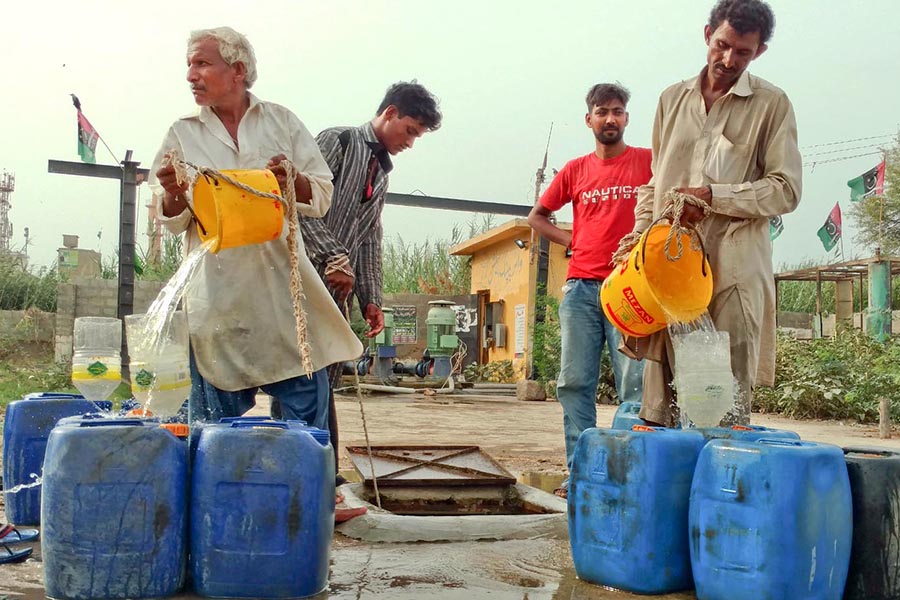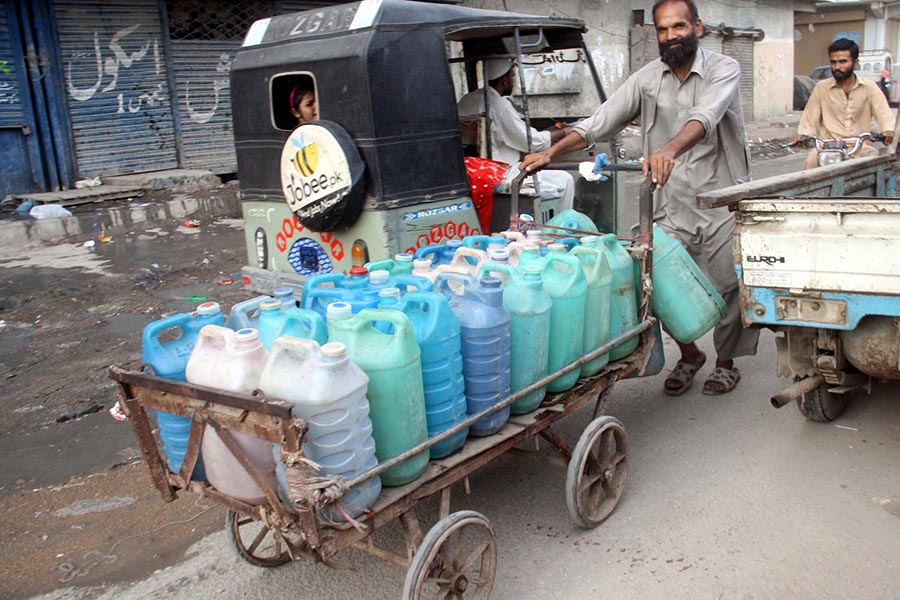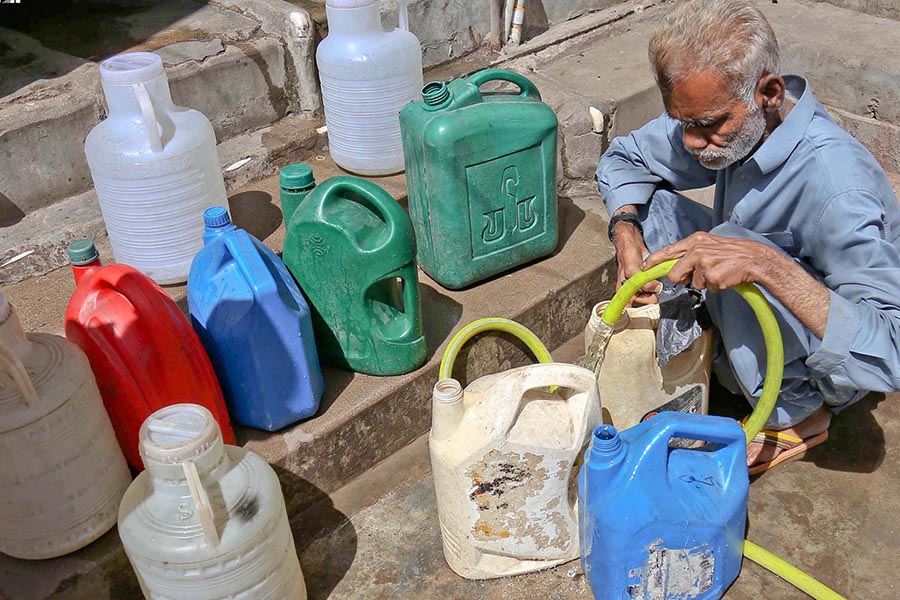Humans need eight glasses of water daily to live a healthy life.
Think about the thirst of the largest city of Pakistan, where over 20 million citizens reside. As per statistics from the Karachi Water and Sewerage Board (KWSB), the metropolis needs more than 1,200 million gallons of water daily. However, water sources are not only far-flung but also getting scarce with each passing day.
Keenjhar Lake serves as a major source of fresh water supply to Karachi. The lake is more than 100km away from the busy metropolis. It provides 550 million gallons of water per day (MGD) to Karachi. The second source is Hub Dam, which can provide 100 MGD but it is solely dependent on rainfall. With the decline in rainfall, water supply from Hub has suffered.
Together, Keenjhar and Hub cannot meet even half of the demand of Karachi. Karachi does not get 600 MGD from its distant and dependent sources. 42 per cent of this water share is lost due to water theft and fragile infrastructure.
Imagine, how would life survive?

K-IV: A ray of hope or a closed tunnel?
The K-IV project was initiated to meet the soaring demand for water in Karachi. The still under-construction project on completion is supposed to provide an additional 260 MGD water to the city. Doubters say K-IV won’t even bridge the gap between demand and supply. On KWSB’s website, the old deadline of 2015 for the project’s completion is shown, however, the current deadline of 2019 seems far from reality.
“K-VI was conceived during my tenure 10 years before,” Mustafa Kamal, ex-mayor of Karachi and now chairman of Pak Sarzameen Party, told Geo News. “It was to meet Karachi’s demands a decade earlier. Due to unprecedented delays, the cost of K-VI project has mounted from 24 billion to 81 billion rupees.”
“Sindh gets 36,370 MGD water as per IRSA Water Accord 1991 whereas Karachi gets merely 550 MGD. The irony is that 50 per cent of Sindh's population dwells in Karachi, but Karachi only receives 1.5 per cent water share to feed its people,” Kamal emphasised.
Parched Pipeline, Dried Hopes
In the city, the gulf between demand and supply is widening. For residents, the search for water is not only time consuming but a strenuous process. A single water pump feeds water to an entire area, kids carry empty water bottles instead of toys.
Residents of Ranchor Line make a long queue in front of a shop where a philanthropist installed a hand pump. Parched water lines have forgotten the taste of flowing water.
“No water is no surprise now”, says Kishan Lal, a dweller in the area.
“May God bless the philanthropist who installed a hand pump or we would have been at the mercy of events,” Kishan Laal said as he picked up his filled cans and disappeared into a crowded street.

The situation in Ranchor Line is not unique to the city. The quest for groundwater is rampant throughout. You cannot walk without stumbling in the streets of Alnoor Society of District Central. Carpeting has long gone because of digging. Mud and dust have replaced wide passages.
“It is all because of water shortage,” says a young man in FB area. “Our area was clean and roads were smooth. We can live with this mess but not without water. There is no other option than digging for groundwater in our area.”
That too is getting difficult and costly with the passage of time.
Environmental studies professor at Karachi University, Dr Amir Alamgir warns that the situation is alarming as now an additional 150 to 250 feet needs to be dug to find water underground.
“The water level is going down due to excessive use of groundwater. This will have its own impact on ecology and the environment.”
The professor adds that even finding water below 250 feet is not the solution.
“We go for tests, from blood test to urine test. But we never go for water testing. In a survey done by the Institute of Environmental Studies, 90 per cent of water samples – collected from different areas of Karachi – were contaminated,” he told Geo News. “It takes a trip to IES in Karachi University or PCSIR to get your groundwater checked. Unfortunately, people desperately need water regardless of its quality.”
Desalination Mantra
The beach located in the south of Karachi is a famous picnic spot. Karachiites and people from other areas have been paying frequent visits to this coastal line. The water and its waves are a pleasant sight for eyes. But one cannot drink this water untreated.
Seawater can be desalinated but this process till now is only being discussed. The Government of Sindh has formed a committee to probe the feasibility of desalination plants in Karachi.
“Desalination is the only way forward because there is a shortage of water in any case. Sindh Government is working on both water treatment and desalination. These are cost-intensive projects and we hope the federal government will provide us with funds for these projects and also fulfil its commitment in respect of K-IV,” Sindh Information Minister Murtaza Wahab told Geo News.
For Karachi, desalination is a very difficult task. The reason is sewage water. This sewage is being dumped untreated into the sea daily. The Supreme Court’s water commission report states that Karachi produces more than 450 MGD of sewage. This includes liquid waste produced by households, businesses, hospitals and industrial units.
This sewage is supposed to be treated by one of the three plants in the city but, as the commission reports, these plants “are all lying nonfunctional”.
Two of them – one in Shershah area near Lyari and the other at Mehmoodabad to the south of Shahrah-e-Faisal – were constructed as far back as 1964 and have been nonfunctional since 2013 and 2009, respectively. The third plant – in western Karachi’s Mauripur area – was built in 1998. It, too, has been nonfunctional since 2013.
Desalinating seawater isn't a feasible option for thirsty Karachi. The huge cost of building desalination plants is just one obstacle. Another is ongoing expenses: desalinating water is energy-expensive, so is adding back essential minerals removed from the water.
“The more dissolved solids are present in water, the earlier membrane of a desalination plant will be damaged. The membrane is most important when we talk about desalination plant and it is most costly. If we do that we are supposed to spend too much on plant’s maintenance,” informed Dr Amir Alamgir.
In Pakistan, it is estimated that around 2,000 million gallons daily and 962,335 million gallons annually of wastewater are being produced and discharged to surface water bodies. This domestic and industrial wastewater is either discharged directly to a sewer system, a natural drain or water body, a nearby field or an internal septic tank. This wastewater is normally not treated and none of the cities have any biological treatment process except Islamabad and Karachi, and even these cities treat only a small proportion (<8%) of their wastewater before disposal.

Warning!
IMF has warned if circumstances do not change for the better, 2025 will bring droughts to Pakistan. Per capita annual water availability in Pakistan has plunged from 1,500 cubic meters per capita in 2009 to 1,015 cubic meters now, which is on the brink of water scarcity, according to the IMF.
Karachi, being the financial capital of the country, is in dire need of attention. Water management package has become inevitable for the metropolis.
Title picture: People filling water cans from a leaking pipeline at Banaras Chowk due to a shortage of water in Karachi - Online


